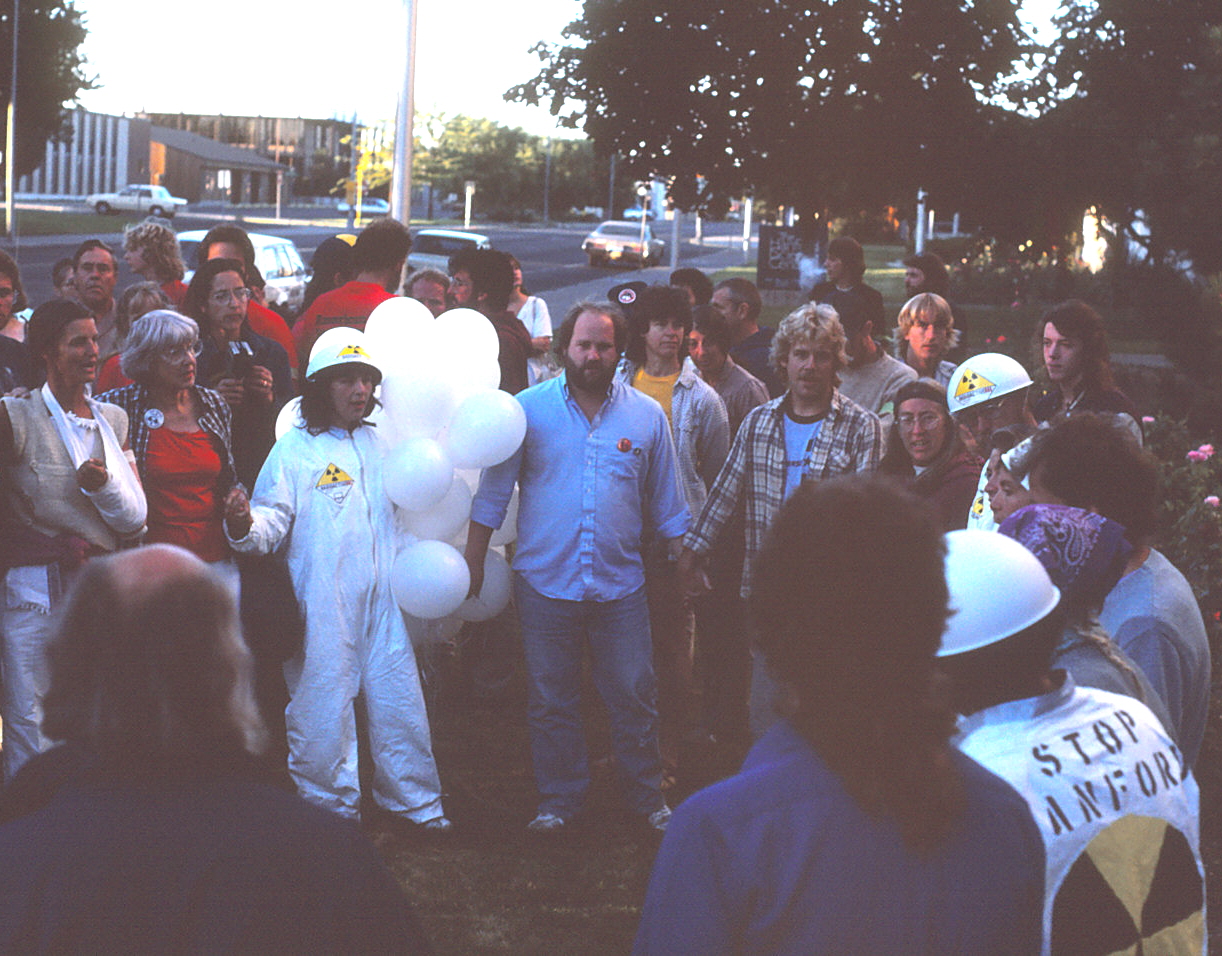 Photo caption:
David Gilkey (center) at an early morning protest demonstration in front of the Richland
Federal Building, August 6, 1986. The demonstration was a prelude to blocking the main
access road to Hanford.
Photo caption:
David Gilkey (center) at an early morning protest demonstration in front of the Richland
Federal Building, August 6, 1986. The demonstration was a prelude to blocking the main
access road to Hanford.
IN MEMORIAM
Archbishop Raymond Hunthausen
Archbishop Raymond G. Hunthausen, who led the Catholic Archdiocese of Seattle from 1975 to his retirement in 1991, died on Sunday, July 22, at the age of 96. He was known for his strong commitment to issues of peace and justice.Archbishop Hunthausen’s passion for peace became known around the world when he protested the proliferation of nuclear weapons, including the housing of Trident missile nuclear submarines at nearby Subase Bangor. He denounced the Trident fleet harbored in his archdiocese, famously calling it “the Auschwitz of Puget Sound.” So convinced was he of the immorality of the buildup of nuclear arms that he began to withhold one-half of his own income taxes in 1982.
In what would become a historic address on June 12, 1981 at Pacific Lutheran University in Tacoma, Archbishop Hunthausen spoke these prophetic words: “Our security as people of faith lies not in demonic weapons, which threaten all life on earth. Our security is in a loving, caring God. We must dismantle our weapons of terror and place our reliance on God.”
Revered as an outspoken advocate for the poor and the marginalized, Archbishop Hunthausen was also a great advocate for women and their role in Church and society. So deeply was he committed to the Church’s ecumenical mission that many clergy of other denominations referred to him as “their bishop.”
For the last several years of his life, Hunthausen lived in a nursing facility in Helena, Montana, where he had previously served as bishop.
Longtime peace activist Deborah Beadle, Yakima, died peacefully on April 3, 2016, of renal failure.
Deborah was very active in Hanford protests during the 1980s and was arrested multiple times for civil disobedience actions. She was also active with the former Jackrabbit Alliance in Yakima and the Yakima Valley Peace Action Network.
On Sunday, April 26, 1987 — the first anniversary of the Chernobyl disaster, Deborah was among about 200 people from around the Pacific Northwest who turned out for a rally in Richland’s John Dam Plaza. N Reactor had just been shut down in January for safety upgrades. The Hanford and Chernobyl reactors were similar and had no containment structure to prevent the escape of radioactivity in case of an accident.
The rally was a prelude to civil disobedience. From John Dam Plaza, a group of us drove 35 miles on the Hanford highway to the Vernita rest stop, just south of the bridge across the Columbia River. There another rally was held, with eleven people who were going to climb the security fence onto the Hanford Site — including Deborah — dressed in radiological white coveralls. Hanford Security had been apprised of the action in advance, so as the eleven bounded over the barbed wire, the Hanford Patrol was ready and waiting to arrest the protesters.
At their trial in Benton County District Court on August 31, 1987, all of the defendants individually testified that they believed their actions were not against the law, based on the Nuremberg Principles which specify that citizens of a country have a right, a duty and a responsibility to act when they see violations of crimes against humanity. Nuclear weapons are included, they testified, because they wouldn’t just destroy military targets, but hospitals, homes and schools.
The jury found all the defendants guilty, and the judge sentenced each to 90 days in jail, with all but two days already served suspended on payment of a $500 fine. Deborah, who had been convicted three times previously for civil disobedience at Hanford, stood and told the judge she didn’t do anything wrong and refused to pay the fine. The judge then sentenced her to 24 days in jail. At that, all the rest of the defendants stood up and accepted the same sentence. The eleven all served their terms and were released to protest another day.
After the Cold War ended and Hanford’s plutonium production for nuclear weapons ceased, Deborah continued to come each August 9th to vigil across from the Federal Building (one of the locations where she had been arrested) and to attend our Atomic Cities Peace Memorial ceremony. Physical disability eventually prevented Deborah from traveling to Richland, but she continued to participate in peace demonstrations in Yakima.
With Deborah’s passing, we have lost a dedicated and inspiring advocate for peace and abolition of nuclear weapons. May she rest in peace.
– PeaceMeal, July/August 2016
Former World Citizens for Peace member David Gilkey died on September 13, 2015, apparently due to insulin shock. He was 54 years old.
 Photo caption:
David Gilkey (center) at an early morning protest demonstration in front of the Richland
Federal Building, August 6, 1986. The demonstration was a prelude to blocking the main
access road to Hanford.
Photo caption:
David Gilkey (center) at an early morning protest demonstration in front of the Richland
Federal Building, August 6, 1986. The demonstration was a prelude to blocking the main
access road to Hanford.
Dave was very active in Hanford protests during the 1980s when the rallying cry was “Shut it down, clean it up!” On August 6, 1986 — the anniversary of the Hiroshima atomic bombing, when Dave was vice-chairman of WCPeace, he participated in a civil disobedience action to block the main access road to Hanford during the morning rush hour. He was one of 29 people arrested for disorderly conduct. At a hearing in November, a district court judge dismissed charges against the defendants on the grounds that the Richland ordinance under which they were arrested was unconstitutionally vague.
Not all went well for Dave, however, who worked as a parole officer for the Washington State Department of Corrections. Because of his arrest, he was denied access to both the county jail and records essential to his work. He was then fired for inability to perform his job. Dave appealed his firing in light of the ruling that the arrest was unconstitutional and, after three months off work, was reinstated.
Dave moved to Des Moines, Washington, where he was a Community Corrections Officer for many years before becoming a supervisor. Later, he took over the work release program in downtown Seattle and worked there for eight years before being promoted to administrator of the statewide Work Release Program in Olympia in 2015. He never tired of working with inmates on supervised release, with the hope that they would turn their lives around. He loved his staff and let them know they were appreciated.
Dave was able to walk his stepdaughter Sara down the aisle at her wedding on September 12, 2015, before passing away in his sleep later that night. He is survived by his wife Lori and Sara.
May he rest in peace.
– PeaceMeal, May/June 2016
IN MEMORIAM
Rev. Bill “Bix” Bichsel, S.J.
May 26, 1928 – February 28, 2015
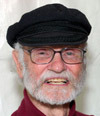 Tacoma-born Jesuit priest Rev. Bill Bichsel protested against U.S.
military programs and nuclear weapons for nearly 40 years, resulting in dozens of arrests.
Known to most people simply as “Bix”, he had a history of heart problems and died
February 28 at the Catholic Worker House in Tacoma after lapsing into a coma. A
cardiologist told him in 2011 he had only one year to live. After already having two
open-heart surgeries, he declined to undergo a third to repair leaking heart valves.
Tacoma-born Jesuit priest Rev. Bill Bichsel protested against U.S.
military programs and nuclear weapons for nearly 40 years, resulting in dozens of arrests.
Known to most people simply as “Bix”, he had a history of heart problems and died
February 28 at the Catholic Worker House in Tacoma after lapsing into a coma. A
cardiologist told him in 2011 he had only one year to live. After already having two
open-heart surgeries, he declined to undergo a third to repair leaking heart valves.
“Bix” repeatedly protested at the Army’s School of the Americas at Fort Benning, Georgia, a training school for Latin American military officers whose graduates have been implicated in gross human rights abuses and atrocities in their home countries.
He chained himself to the doors of the federal courthouse in Tacoma after the U.S invasion of Iraq. And he protested Trident submarines and their nuclear-tipped missiles at the Navy’s Bangor submarine base on Hood Canal.
More quietly, he also helped feed and shelter homeless people in Tacoma as part of the Tacoma Catholic Worker community he co-founded in 1989. His belief in caring for each person as family was rooted in the example set by his mother and her care for family and community, especially during the Great Depression.
In 2009, “Bix” took another step that proved to be controversial. He helped lead a group that traveled to Japan to ask forgiveness for the destruction caused by the U.S. atomic bombings of Hiroshima and Nagasaki in 1945. The so-called “Journey of Repentance” sparked an outcry from those who said it ignored the attack on Pearl Harbor and atrocities committed by the Japanese military during World War II.
“Bix” was arrested some 45 times for trespassing during protests. He was convicted and incarcerated more than a half-dozen times, spending about 2½ years in jails and prisons. His last arrest came in July 2010 for trespassing in protest at a plutonium processing plant near Knoxville, Tennessee.
In 2011, he expressed no regrets when he and four other protesters were given prison sentences by a federal judge in Tacoma for breaking into the Bangor sub base in 2009 to protest nuclear weapons. They were convicted of using bolt cutters to cut through three chain-link fences to enter an area where nuclear warheads are stored.
“Bix” called his protests civil resistance — not civil disobedience — because he didn’t believe he was breaking the law. He said he was upholding international laws, such as the Principles of the Nuremberg Tribunal, which prohibit war crimes and crimes against peace and humanity.
Nearly 1,000 people turned out for the funeral Mass on March 14 at Tacoma’s St. Leo Church to pay their respects to one of the most visible and admired protesters for peace in the Pacific Northwest.
May he rest in peace.
– PeaceMeal, March/April 2015
IN MEMORIAM
Rita Chott Plachta
January 5, 1916 – April 22, 2013
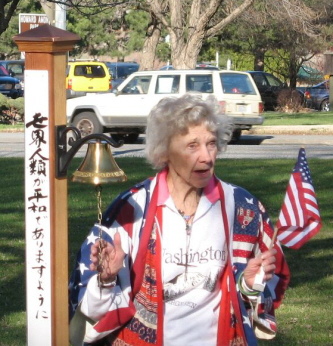 Rita Mary Chott was born in St. Louis, Mo., and moved with her
farming family to Texas and then Yakima, Wash. After high school, she attended Seattle
College (now Seattle University) and earned a degree in nursing. While at Seattle College,
Rita met fellow student Alfred Plachta. They were married on Dec. 30, 1942, and began
their family of eleven children. After several moves, they settled in Richland, Wash.
Rita Mary Chott was born in St. Louis, Mo., and moved with her
farming family to Texas and then Yakima, Wash. After high school, she attended Seattle
College (now Seattle University) and earned a degree in nursing. While at Seattle College,
Rita met fellow student Alfred Plachta. They were married on Dec. 30, 1942, and began
their family of eleven children. After several moves, they settled in Richland, Wash.
Rita worked as a Registered Nurse throughout her married life. She lived her beliefs in justice, peace and the fundamental dignity of all human beings. Thus, she tended to the sick, comforted the suffering, fed the hungry and worked for peace.
Rita participated in the activities of World Citizens for Peace well into her 90s. She was one of the regulars during our years of protesting the Iraq War, often riding her bicycle to the sidewalk by City Hall where we held our demonstrations. She displayed one of our “No War” buttons on her front door.
Rita lived the last year of her life with daughter Agnes and her husband in Spokane, Wash. She died there on April 22, 2013, at the age of 97. She is survived by ten children, 17 grandchildren and 17 great-grandchildren. A funeral Mass was held May 11 at Christ the King Church in Richland.
Rita was a compassionate soul who served as an exemplary role model for others. Her gentle spirit lives on in those whose lives she touched.
– PeaceMeal, May/June 2013
IN MEMORIAM
Aloysius “Al” Mangan Jr.
July 24, 1922 – March 30, 2013
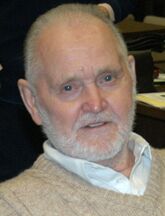 Al
Mangan was born in Oakland and grew up in Burlingame, Calif. He served in the U.S. Navy
during WWII and in the U.S. Army during the Korean War. He settled in Spokane, Wash., and
worked for the Postal Service for most of his adult life.
Al
Mangan was born in Oakland and grew up in Burlingame, Calif. He served in the U.S. Navy
during WWII and in the U.S. Army during the Korean War. He settled in Spokane, Wash., and
worked for the Postal Service for most of his adult life.
Al was a champion for peace, justice and human rights. He volunteered with many organizations dedicated to those causes. After retirement, he devoted his life to the causes that were dear to him: ridding the world of nuclear weapons; defending treaty rights of Native-Americans; and protesting U.S. involvement in armed conflicts around the world. He often found himself behind bars as a result of his non-violent protests.
During the 1980s, Al participated in World Citizens for Peace activities opposing the nuclear arms race and Hanford’s production of plutonium for nuclear weapons. He was arrested and served jail time at least once for civil disobedience here.
With the infirmities of age, Al moved to San Jose, Calif., to live with his son and daughter-in-law, Roland and Inés. He died on March 30, 2013. A memorial Mass was held April 5.
Al was preceded in death by sons Mark and Barry. He is survived by ex-wife Vivian Bradford, three sons – Rohry, Roland and Robert, and four daughters – Carol, Kathleen, Mary and Pamela. He had 14 grandchildren and five great- grandchildren.
Those of us who were privileged to know Al mourn a dedicated peace activist and dear friend.
– PeaceMeal, May/June, 2013
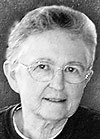 IN MEMORIAM
IN MEMORIAM
Jackie Hudson, activist nun for nuclear disarmament
A year ago, Jackie Hudson, 76, a Dominican nun based in Kitsap County, crawled under a barbed-wire fence in Oak Ridge, Tenn., in protest of the plant that produced enriched uranium for nuclear weapons. She was found guilty and was awaiting her sentence. It was part of her life mission to support nuclear disarmament.
Sister Hudson was raised in Saginaw, Mich., joined the Dominican order in 1952, and taught music in schools for 29 years. She died August 3 of multiple myeloma at Harrison Medical Center in Bremerton.
Longtime friend Sue Ablao, who often demonstrated with Sister Hudson, said social justice was her life’s work. The two met in Michigan when Ablao walked into the Institute for Global Education in Grand Rapids, where Sister Hudson was program director. When asked what she could do, Sister Hudson said she had three buses heading to Washington, D.C., for a protest and Ablao was hooked.
In the early 1990s, the two decided to move to Washington state, where Ablao’s family lived, and became caretakers at the Ground Zero Center for Nonviolent Action in Poulsbo, which organizes protests at the nearby Trident nuclear submarine base. Some 1,700 thermonuclear warheads are based there.
Sister Hudson was arrested at least a dozen times and also served time in prison, said Ablao. Once, she and two other women went into a Minuteman missile site in Colorado, pounded on the cover of a missile silo and prayed for nuclear disarmament, Ablao said. For that she served 18 months in federal prison.
Her brother, Frank Hudson, said his sister loved teaching and that her passion for nuclear disarmament was an extension of her care and concern for young people. “A lot of what drove her had to do with keeping the world safe for the kids.”
A memorial service was held for Sister Jackie Hudson on August 13 at the Ground Zero Center for Nonviolent Action.
– edited from the Seattle
Times, August 12, 2011
PeaceMeal, Sept/October 2011
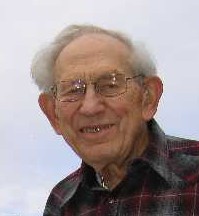 IN MEMORIAM
IN MEMORIAM
R. J. “Dick” Brouns, 1917-2009
Richard (Dick) J. Brouns, age 91, one of our staunchest protesters of the war in Iraq, died August 25, 2009, after a battle with Alzheimer’s disease.
Always together with his late wife, Nyla, who died two years ago, Dick committed his life to working for world peace, social justice and human dignity. Together Dick and Nyla were active in organizations such as CORE (Congress of Racial Equality), NAACP, United Farm Workers, Democratic Party, Tri-Cities Food Bank, Christ the King Church social justice and peace committee and World Citizens for Peace.
Dick was born in Osakis, Minnesota, on October 2, 1917, the oldest of 7 children. He grew up on the family farm and, after high school graduation, attended St. John’s University in Collegeville MN and Iowa State University, where he obtained a doctorate degree in chemistry. Dick moved to Richland WA in 1948 to work as a chemist for General Electric Co. and later Battelle, Pacific Northwest Laboratory, until his retirement in the early 1990s. In 1952, Dick and Katherine Nyla Neidhold married and had 55 loving years together.
Dick left an indelible mark on almost everyone he encountered and was a powerful example to his six children and ten grandchildren. He was a pillar of the community whose deep faith, passion for nature, and never-ending love for his family, friends and community will be greatly missed.
A funeral Mass of Christian Burial was held September 1, 2009, at Christ the King Catholic Church in Richland.
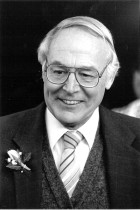 IN MEMORIAM
IN MEMORIAM
David C. King, 1926-2009
David C. King, 83, a veteran of World War II and one of our dedicated members during the Nuclear Freeze era of the 1980s, died September 6, 2009, in Monmouth, Oregon. David was born March 8, 1926, in Berea, Ohio, where he graduated from high school in 1944. Four months later he was drafted into the Army, went through basic training and shipped out to combat in the Philippines. When World War II ended, he volunteered for the 11th Airborne Division and spent the balance of his service days in Sendia, Japan.
After being discharged in 1946, David earned a degree in mechanical engineering from Case Institute of Technology, Cleveland, Ohio, and a masters of science degree from Oregon State University. All of his postwar worklife was as an engineer in the nuclear industry, which brought him to the Tri-Cities in the early 1970s to work for the U.S. Department of Energy. In 1983 David married JoAnn Gayler Grund.
A longtime Methodist, David’s interests were the church, peace and social justice. When he retired from DOE in 1988, he and JoAnn moved to Monmouth, where he volunteered in many areas of community service. In 2002, David and JoAnn were presented with the Monmouth-Independence Chamber of Commerce First Citizen Award.
David’s calm demeanor and gentle humor gave him a quiet charisma. He will be long remembered for his goodness, integrity and the joy felt when in his presence. In addition to his wife JoAnn, David is survived by three children, three stepchildren, and 16 grandchildren.
A Memorial service was held Sept. 14, 2009, at Christ’s Church Methodist and Presbyterian United in Monmouth, Oregon.
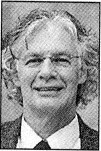 Transit system renames center for Ed Frost
Transit system renames center for Ed Frost
Ben Franklin Transit recently renamed the transit center on Kennewick’s Huntington Street as the Edwin G. Frost Transit Center at Huntington. It’s to honor Ed Frost, World Citizens for Peace chairman 1989-1995, for his distinguished service to the transit agency. Tim Fredrickson, transit’s general manager, said, “Ed has been a part of every major development and decision that has made BFT the great organization it is today.”
Ed retired in January 2009 as Director of Development after working for the transit agency for 27 years. A dedication ceremony is planned in June.
Congratulations, Ed!
– info from the Tri-City Herald, May 22, 2009PeaceMeal, May/June 2009
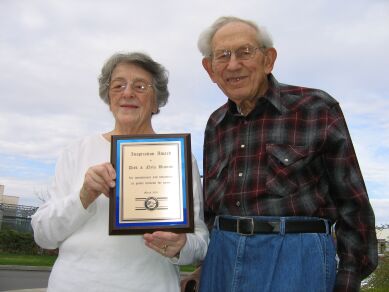 IN MEMORIAM
IN MEMORIAM
Katherine “Nyla” Brouns, 1922-2007
We are saddened to report the death of Katherine “Nyla” Brouns, a longtime Tri-Cities activist for social justice and peace. Nyla, 85, died peacefully at home on September 1, 2007.
From the time she was arrested picketing for racial equality in the 1960s through her crusading for migrant farmworker rights to her public opposition to the Iraq war, Nyla was accustomed to being in the minority. She prided herself in having rebelled through tumultuous times and having witnessed the Tri-Cities’ conversion into a more diverse and egalitarian community. Although her accomplishments remained grass roots, family and friends attest to her conviction in her ideals and her courage in promoting unpopular positions.
Nyla respected rules and institutions, according to her youngest son, Tom Brouns, but she balanced that with a passion for justice and peace that often caused her to break the rules.
In the 1960s, Nyla battled for racial equality one-on-one. In one case, she pretended to be the white renter of a middle-class Richland home when a black friend found it difficult to break through the racial barrier. In another instance, she protested a racist speaker at a local elementary school. She didn’t change the world, but she made a difference in her corner of the world.
Nyla was born on June 5, 1922, in Wausau, Wisconsin, where she graduated from high school in 1940 and from Saint Mary’s Hospital Nursing School in 1943. She then joined the U.S. Army Nurses Corps and proudly served her country during World War II, earning the rank of lieutenant. Nyla moved to Richland in 1946, where she met and married Richard “Dick” Brouns.
Nyla had a long and successful career as a public health nurse before her retirement in 1988. She and Dick were active members of their church as well as the Democratic Party, plus local and national organizations for racial equality, social justice, women’s causes and peace. They were both regulars on the sidewalk during WCPeace’s five years of protesting the ongoing U.S. war in Iraq. For their commitment and dedication to public witness for peace, Nyla and Dick were awarded a special Inspiration Award by WCPeace in 2005.
In addition to her husband of 55 years, Nyla is survived by their 6 children, 10 grandchildren, and 3 great-grandchildren.
–
edited from the Tri-City (Wash.) Herald
PeaceMeal, Sept/October 2007
A beautiful summer evening brought some 48 grownups and children together in Richland’s John Dam Plaza on August 9, 2007 to commemorate an historic tragedy and express hope that it never be repeated. Our Atomic Cities Peace Memorial ceremony was an hour-long program of speech, song and prayer that took place within a circle of peace lanterns on the anniversary of the Nagasaki atomic bombing. We were especially honored to have with us Rev. Senji Kanaeda and Rev. Gilberto Perez, Buddhist monks from the Nipponzan Myohoji temple on Bainbridge Island. They returned to Richland, following completion of the Interfaith Peace Walk they led in July from Hanford to the Trident nuclear submarine base at Bangor, to do a chant and prayer on the Memorial program.
In accordance with the theme of reconciliation, those who died on both sides of the war with Japan were memorialized. Representing all the Americans who died in the war was a United States flag that has flown over the sunken battleship Arizona in Pearl Harbor. Representing the Japanese who died was the “Bell of Peace,” a model of a bell recovered from the ruins of a church at ground zero in Nagasaki. The “Bell of Peace” — a gift from the mayor of Nagasaki to the city of Richland in August 1985 — was rung in memory of both the Americans and the Japanese who died in the war.
– PeaceMeal, Sept/October 2007
Peace flows as 2007 interfaith walk visits Hanford
Gene
Weisskopf, Vice Chairman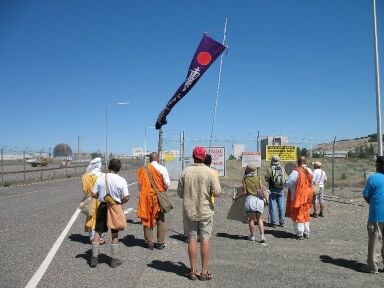
Photo caption: Interfaith Peace Walk 2007 at the Hanford 300 Area gate. Photo by Gene Weisskopf.
The Interfaith Peace Walk 2007, a 300-mile pilgrimage for nuclear disarmament and world peace, arrived in Richland on Monday, July 23, under the theme “Hiroshima-Nagasaki to Hope.” The troupe of peace walkers was led by organizers Rev. Senji Kanaeda and Rev. Gilberto Perez, monks from the Nipponzan Myohoji Buddhist Temple on Bainbridge Island (nipponzan.net), and Rev. Gyoki Makino, who was visiting from Tokyo. Accompanying them were ten fellow walkers, including two high-school students from Japan and others from as far away as California.
Following an opening ceremony in the John Dam Plaza, the walkers were invited to Shalom United Church of Christ for a wonderful dinner, followed by an Evensong service of music, poetry, prayers, meditations, photographic slides, and, most evidently, warmth and fellowship.
After a night’s sleep at Christ the King School, the peace walkers set out Tuesday morning on Stevens Drive for a 7-mile walk to the Hanford 300Area. The walk itself was not a protest but a prayer walk, accompanied by beating drums and chanting “Na-Mu Myo Ho Ren-Ge Kyo,” which means “Peace beyond understanding through spiritual enlightenment.”
The weather was not as hot as the previous day, with a light breeze and skies above clear for 100 miles in all directions. At the south gate of the 300 Area, the group paused, said prayers, and no doubt reflected on the historical path they had followed 62 years after Hanford produced the plutonium for the Nagasaki atomic bomb.
That evening, members of Christ the King Church served dinner to the walkers at the church. Lights-out came earlier rather than later after the day’s 14-mile round trip in the fresh, dry air of a Richland summer. The following morning, the group drove off to Centralia, where they would continue their walk, eventually passing through Seattle and culminating August 6 at the Trident submarine base at Bangor, home base of some 2,000 thermonuclear warheads.
The interest and attention the walkers drew went a long way toward reminding us that, after 62 years, we’re still living under a nuclear peril. It was good to know that there are many people in the world, who are working incessantly, albeit quietly, to eliminate the threat of nuclear annihilation. To paraphrase the theme of their walk and their work, “We can’t have world peace without abolishing nuclear weapons.”
Group rallies against Iraq war on 4th anniversary
Gene Weisskopf, Vice Chairman
The Iraq war has gone on longer than our involvement in World War II, and there’s still no end in sight. On Saturday, March 17, 2007, World Citizens for Peace held a rally in Richland’s John Dam Plaza to commemorate the 4th anniversary of the war. Voices were heard that expressed our continued revulsion, outrage, dismay, horror, and regret at the carnage we have spread in Iraq and the instability we have sown in our international relations. The list of dire consequences goes on and on.
The day was exceptionally warm, a perfect day for an outdoor event. Although perhaps too perfect, given the purpose of the gathering. I stood in as master of ceremonies for the event, a responsibility and small chore that was both an honor and wonderful opportunity to speak out against the war, yet again.
This year, lacking anything new and inspiring to say about this four year old debacle, I harkened back to words spoken 40 years ago about another war in another far off place. These words carried extra weight, because they were spoken by Martin Luther King in his campaign to end the war in Vietnam. Although most remembered for his civil rights campaign, the Reverend was also vehemently opposed to the war we were fighting in Vietnam.
After my introductory words, I brought out my guitar and sang a 42-year-old song by Phil Ochs called “I Ain’t Marchin’ Anymore.” The title is the theme and refrain of the song, and its message speaks out every bit as true today as it did during the Vietnam era.
Next on the agenda, Ed Frost, former chairman of World Citizens for Peace, spoke about the constant refrain we hear, “Support the troops.” He pointed out how the recent revelations of sub-standard conditions at the Walter Reed Army Medical Center are yet further evidence of just how little the Bush administration is actually supporting our troops.
Then, in a show of how like minds can share the same pathways, our barefoot Ambassador of Peace, Victoria Lewis, presented a selection of quotes from Martin Luther King’s same speech about the Vietnam war. The overlap in her thoughts and mine only emphasized the tragedy of our nation not having learned the lessons of the Vietnam war. Now we are repeating that tragic history in Iraq.
Then it was time for a group song, the still relevant and touching, “If I had a Hammer,” from 1949 by Lee Hays and Pete Seeger. It was an appropriate lead-in to the ringing of the Peace Bell, introduced by WCPeace chairman Jim Stoffels. Jim invited all of us to take a turn at ringing the bell for peace in the world. Some said a few words before they rang the bell, others simply let the bell speak for them.
Our youngest attendee, Gizi Lewis (just recently a teenager, daughter of Victoria and Bob), eloquently expressed her own regrets at having to grow up while this war is raging, without any way to stop it. Although adults, in theory, have more to say about wars and the like, Gizi’s words were truly a powerful stroke against the madness of our “adult” behavior.
At the end of the program, we all moved with our signs and flags to the sidewalk along George Washington Way, facing the fifth year of a war that didn’t have to be.
We are saddened to report the untimely death of Patrick Buller, one of the founding members of World Citizens for Peace in 1982 and husband of Eileen Buller, our founding secretary.
At that time, Patrick was a communications engineer working for Rockwell Hanford Co. In August 1983 during our Nagasaki-Hiroshima Memorial ceremony, Patrick spoke out in public criticism of Hanford operations for the first time. President Ronald Reagan had restarted production of weapons grade plutonium at Hanford after it had been shut down during the 1970s. On October 1, 1983, the day scheduled for the PUREX plant to again begin chemically separating plutonium from uranium fuel irradiated in the N Reactor, Patrick Buller announced his resignation. The Bullers moved across the Cascade Mountains to Issaquah, where Patrick went to work for the Washington State Patrol at an annual salary $13,000 less than he was making at Hanford.
Patrick died September 18, 2006, at his home in Issaquah, shortly after being diagnosed with cancer. He was 70½.
– PeaceMeal, Sept/October 2006
Voices for Peace ring out on 3rd anniversary of Iraq war
Gene Weisskopf, Vice Chairman
The 47 people who gathered in John Dam Plaza in downtown Richland on March 18, 2006 to mark the third anniversary of the U.S. invasion of Iraq may not have equaled the 7,000 who rallied in New York's Times Square. But when you factor in population, political leanings, and community vocal power, our gathering in Richland was, indeed, huge.
After three and a half years of a nation slipping and being shoved into the yawning pit of an endless, unjustified, unprovoked, and ill-defined war, the day was tinged with dark, looming shadows. But the presence of such a gathering in the face of this national meltdown was a heartening one that certainly bolstered the spiritual backbone of this participant.
I had the honor of playing master of ceremony, which also gave me an opportunity to spend a few minutes pointing out the depths to which our country has slipped over the past three years — speaking of the dark, looming shadows.
Chuck Eaton then took the podium to read four poems from the collection Poets Against the War. He explained how the poetry collective got started, when poet Sam Hamill declined an invitation to the White House before the war began in 2003, because his conscience could not let him take any part in promoting the White House agenda. Instead, he reconstituted Poets Against War, basing it on a similar group that was active during the Vietnam War. You can read about them, as well as some of the 20,000 poems that have been contributed, online at: www.poetsagainstthewar.org
Mike and Shannon Truex brought their guitar, their voices, their musical perspective — and their daughter Myrah — and played and led us in three songs, proving, once again, that peace rallies are great excuses for wonderful music.
Victoria Lewis, our barefoot ambassador of peace, read a letter that Joseph W. DuRocher, a former naval officer, had written to President Bush. In the letter, he expressed his great disappointment, verging on disgust, with the direction our country has gone since we started our war on Iraq. Notably included in the letter were his "boards of rank and Naval Aviator's wings," as he explains in the last paragraph of the letter:
"... I am saddened to give up my wings and bars. They were hard won and my parents and wife were as proud as I was when I earned them over forty years ago. But I hate the torture and death you have caused more than I value their symbolism. Giving them up makes me cry for my beloved country."
To express her empathy for Mr. DuRocher's position, Victoria said she would be mailing her own insignias of service in the Air Force to President Bush, along with a letter that, we're sure, will be every bit as poignant as the one she read.
Finally, Jim Stoffels, chairman of World Citizens for Peace, took the podium to explain the origins of the Peace Bell that we normally use at these events. He then invited anyone from the gathering to ring the bell a time or two in the name of peace. Over the next ten minutes, the center of Richland reverberated with the bell's tolling and the unnamed voices of reason who spoke out in the midst of the war's madness.
Interfaith Peace Walk 2005 inspires
The Interfaith Peace Walk, a 300-mile pilgrimage from the Hanford Nuclear Site at Richland, Washington, to the Trident nuclear submarine base at Bangor, Washington, began on July 16, 2005, in Richland and ended on August 7 at Bangor. Hanford is the site where plutonium was produced for the Nagasaki atomic bomb and most of the U.S. nuclear arsenal. Bangor — located 20 miles across the water from Seattle — is the Navy base for 9 nuclear submarines, 192 Trident ballistic missiles, and approximately 2,000 thermonuclear warheads (hydrogen bombs). It is the largest active nuclear weapons depot in the world.
Under the theme "Hiroshima-Nagasaki to Hope," the Interfaith Peace Walk was in commemoration of the 60th anniversary of the catastrophic destruction of Hiroshima and Nagasaki by atomic bombs. It was organized by the Nipponzan Myohoji Buddhist Temple on Bainbridge Island (www.nipponzan.net) and the Ground Zero Center for Nonviolent Action (www.gzcenter.org), Poulsbo, Washington.
The Hanford beginning of the Interfaith Peace Walk was not only an inspiring experience, but also a flawless success — except for a few blisters. Forty people attended the opening ceremony in John Dam Plaza on Saturday, July 16. And a dozen completed the 12-mile round-trip trek from Richland to the Hanford 300 Area gate on Sunday, July 17, under bright sun and 95 degree temperature.
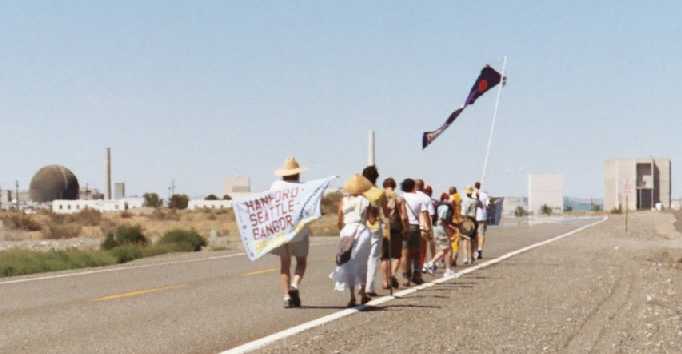 Caption: The
Interfaith Peace Walk approaches the Hanford 300 Area
Caption: The
Interfaith Peace Walk approaches the Hanford 300 Area
Photo by Jim Stoffels
Rev.Senji Kanaeda and Rev. Gilberto Perez, monks from the Nipponzan Myohoji Buddhist temple on Bainbridge Island who organized the walk, led the peace walkers with continual beating of drums and chanting the Japanese prayer, “Na-mu Myo-ho Ren-ge Kyo,” which means, “Peace beyond understanding through spiritual enlightenment.”
The out-of-town peace walkers were especially appreciative for the generous hospitality of two Richland churches: Christ the King Catholic Church and Shalom United Church of Christ. Many thanks to the pastors and people of those congregations, as well as our own World Citizens for Peace-niks who helped and participated.
Chairman Jim Stoffels gave a half-hour slide presentation for the walkers Saturday night on the history of “World Citizens for Peace and The Bomb.” During an hour of discussion that followed, Rev. Kanaeda shared that his parents were living in Kokura, Japan, on August 9, 1945. Kokura was the primary target for the plutonium bomb, but cloud cover prevented visual bombing; so, the B-29 carrying the bomb went on to its secondary target — Nagasaki.
On Monday, July 18, the Interfaith Peace Walk departed for Toppenish, where the walkers were hosted by the Yakama Nation, then through the Columbia River Gorge to Hood River, Portland, and Astoria, Oregon. From there the walk returned to Washington State for segments in Olympia, Tacoma, Seattle, and other communities before reaching the Trident nuclear submarine base at Bangor on Hood Canal on August 7.
– PeaceMeal, July/August 2005
Monks, activists begin pilgrimage at Hanford
By Annette Cary, Herald staff
writer
Tri-City (Washington) Herald, Monday, July 18th, 2005
A banner with a red circle symbolizing light shining into the purple darkness fluttered in the wind Sunday afternoon against the backdrop of the gray buildings, the tall stacks and the round dome of the Plutonium Recycle Test Reactor of the Hanford nuclear reservation.
"Peace beyond understanding through spiritual enlightenment," Jim Stoffels, chairman of World Citizens for Peace in Richland, said was a rough translation of the banner's characters.
Head bowed, a Buddhist monk in a saffron cloth beat out a slow rhythm on a drum to accompany his chant for peace.
Kaori Ishikawa of Seattle waved purifying smoke from a white sage smudge stick, a gift from the Hopi in Arizona, over the 17 people who assembled outside the gates of Hanford's 300 Area. Then she crouched in the rocky desert sand to pray beneath the scarf that hid her face.
Sixty years and one day ago, the first nuclear bomb exploded in the New Mexico desert using plutonium produced at Hanford. Within weeks of that test, the United States had dropped two nuclear bombs over Japan, one of them using Hanford plutonium.
World War II would end, but the bombs would kill about 115,000 people.
In commemoration of the 60th anniversary of the bombings, the Nipponzan Myohoji Buddhist Temple on Bainbridge Island organized an interfaith peace walk with stops across Washington and Oregon to call for the abolition of nuclear weapons.
The pilgrimage began this weekend with a stop by a dozen walkers outside the 300 Area gate at south Hanford. Walkers will end their march near Seattle at the Trident nuclear submarine base at Bangor, the largest active nuclear weapons depot in the world, on Aug. 7, the day after the anniversary of the Hiroshima bomb.
The eight walkers who will make the pilgrimage to the west will sleep in churches and coffeehouses that have offered space along the route, and be joined at each town by local peace activists for marches and prayers.
In Richland, before the walk to the gates of Hanford Sunday, about 40 people gathered in John Dam Plaza for opening ceremonies Saturday.
There monk Senji Kanaeda, one of two Buddhist monks leading the peace walk, made clear why they had come to Richland. He read the remembrance written by a 16-year-old student 60 years ago in Nagasaki:
"The fire went out and after awhile I went home desperately seeking my mother.
Finally I found her dead and in a horrible shape.
Her head was still smoldering and white smoke was rising up.
I cried in tears and held her body in my arms.
And then, I beat her body madly and smashed it into pieces.
I covered her with hot roof tiles as a mark and left that place wailing."
© 2005 Tri-City Herald. Reprinted with permission.
Photo caption: Norb Drouhard in front of the Federal Building, Richland, Wash., August 9, 1988.
Norb Drouhard, aka “No More Nukes,” 80, died peacefully in his sleep during the night of April 5, 2005 at the Catholic Worker House in Las Vegas, Nevada. Norb is survived by his former wife and friend, Pat Drouhard of Moses Lake, five children and nine grandchildren.
Following service in the U.S. Army during World War II, Norb farmed for most of his adult life in Kansas and the Columbia Basin of Washington State. After his retirement from farming, Norb became an activist protesting plutonium production at the Hanford Nuclear Site during the Nuclear Freeze movement of the early 1980s. He later began a nomadic life of peace and social justice activism that took him to various parts of the United States and the world.
Norb took part in protests at the Nevada Test Site, the School of Americas (Fort Benning, Georgia), and other important sites in the military-industrial complex. He participated in major transcontinental peace walks in the United States and transnational walks in Europe — including several in the former Soviet Union, where he lived during the mid-1990s.
No matter where he went, Norb’s friendly outspoken manner, button-bedecked attire, and folksy hand-lettered protest signs often caught the attention of the news media. He was a colorful, caring and committed crusader for peace, with a strong sense of morality and social justice. His death is a loss to the peace movement that will be felt most acutely by those of us who respected and loved him.
~ Jim Stoffels, PeaceMeal, March/April 2005
Hiroshima
Flame visits Hanford 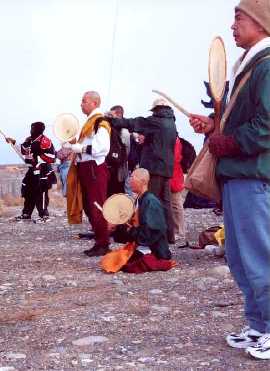
"Na mu myo ho go ren ge kyo."
That constant chant to the beat of drums accompanied the peace walkers on the Hiroshima Flame Interfaith Pilgrimage who visited Richland and Hanford on January 30, 2002. It was one day of a five-month trek across the United States that will end in May at the United Nations in New York.
When the peace pilgrims arrived in Richland around 9:00 am, they began walking at a brisk pace from the south side of town to the Shalom United Church of Christ on the north side. Upon arriving at Shalom Church, there was a service with the Hiroshima Flame — a ceremonial flame originally lit from the rubble of Hiroshima after its atomic bombing.
The main walk of the day was from the church to the Columbia River, north to the Hanford 300 Area gate where there was another period of drumming, chanting and praying, and back a distance of 12 miles. In the evening, there was a potluck dinner and another service for peace with the Hiroshima Flame at the Community Unitarian Universalist Church in Kennewick.
The peace walk was led by Jun Yasuda, a Japanese Buddhist nun, and Tom Dostou, a Native American peace activist from Massachusetts — the first Native American I ever met with a Boston accent. Tom had been on a Hiroshima Flame peace walk from Tokyo to Hiroshima in 2000 and wanted to do one in the United States that focused on nuclear weapon sites and on Native American lands and peoples affected by them.
Two Buddhist nuns and one monk on the walk belong to Nipponzan Myohoji, a Buddhist order dedicated to peace ministry. Building peace pagodas and walking for peace is what they do. Their order built a peace pagoda on Bainbridge Island, Washington, in 1983 as a peace witness near the Trident nuclear submarine base on Hood Canal.
The importance of their walking for peace was forcefully brought home by a story related to me. An old monk who could no longer walk immolated himself by setting himself on fire. He left a note which said: "My knees are gone. I have no reason to live. I will see you in the next life." The old monk was referring to the next life of reincarnation, not to an afterlife with God. In the Buddhist faith there is no deity.
The Hiroshima Flame Interfaith Pilgrimage has no budget. The peace pilgrims go from town to town, relying on the generosity of local people for food, housing, and transportation.
On Thursday we drove the peace pilgrims to Portland, with a stop at the Umatilla Chemical Weapons Depot in Oregon where a multi-cultural prayer circle was held.
>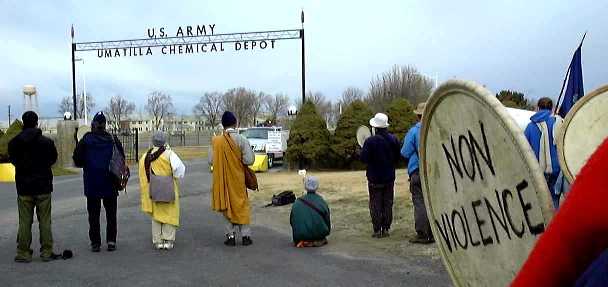
The Buddhists did their drumming and chanting in Japanese. Gregory Dean Smith (aka "Smitty from the City") sang a prayer in an African dialect. Tom Dostou began a Native American chant with gourd rattle that turned into "Amazing Grace."
Special thanks to Shalom United Church of Christ and the Community Unitarian Universalist Church for their kind and generous hospitality. Also to Mike Brown, the Tri-City coordinator of the event, and to Mary Oliver and Gene Weisskopf, who each drove a carload of the peace pilgrims to Portland.
- Jim Stoffels, chairman and editor
PeaceMeal, Jan/February 2002